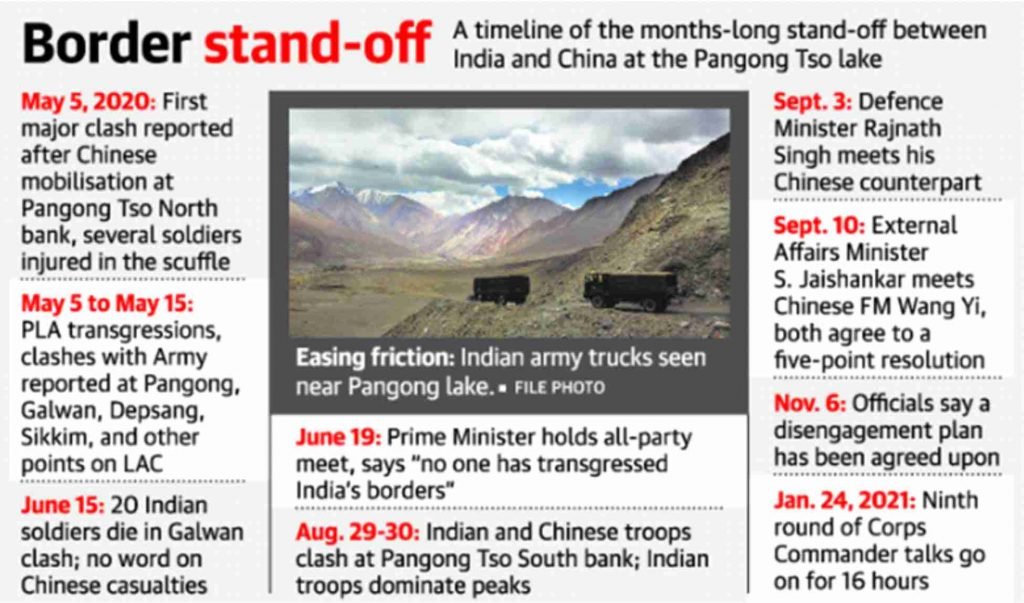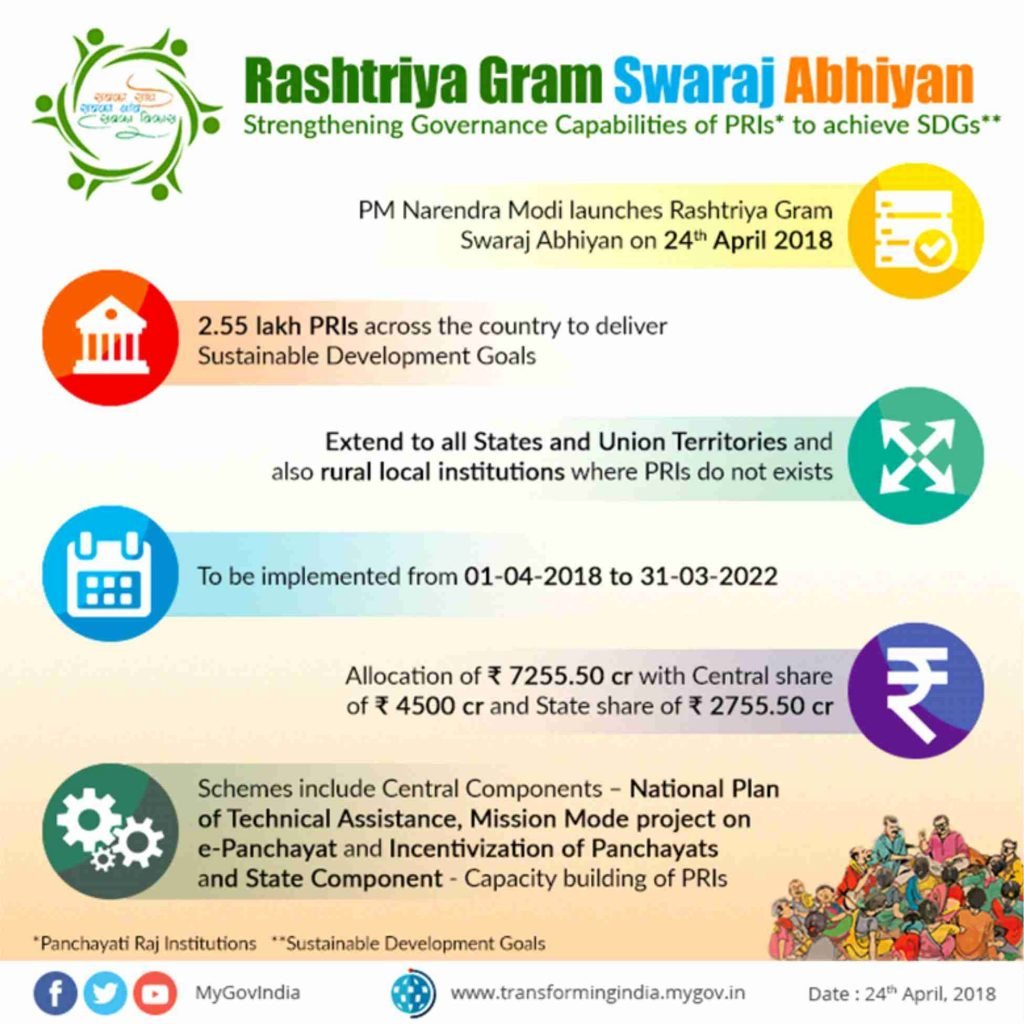Current Affairs (11th February 2021)
DISENGAGEMENT IN Pangong lake
CONTEXT:
- China’s military announced that frontline troops of India and China had begun disengaging in a “synchronised and organised” manner from the north and south banks of Pangong lake, where both sides have been locked in a stand-off for months which was the first step in the long process of disengagement and de-escalation.

ABOUT:
- This is the first phase of disengagement with some tanks and armoured elements on the south bank being withdrawn as well as thinning down of troops on the north bank. However, troops continue to remain in key positions.
- It would be a multi-step process for disengagement and de-escalation along the Line of Actual Control and would take time.
- The Chinese and Indian frontline troops at the southern and northern banks of Pangong Tso start synchronised and organised disengagement from February 10.
- This move is in accordance with the consensus reached by both sides at the 9th round of China-India Corps Commander-Level Meeting.

SVAMITVA scheme
CONTEXT:
- Drone survey under the pilot phase of the central scheme SVAMITVA, which aims to provide an integrated property validation solution for rural India, has been completed in about 23,300 villages of nine states
- Property Cards have been prepared and distributed/under distribution to about 2.30 lakh property holders of about 1,432 villages.
ABOUT:
- SVAMITVA, which was launched by Prime Minister on National Panchayat Day on April 24, 2020, has been sucessful in solving property related disputes in the villages of Haryana and elsewhere where the pilot phase has been implemented so far.
- A total of Rs 913.43 crore has been provided to the Ministry of Panchayati Raj (MoPR) in Budget 2021-22, a 32 per cent increase over the revised estimate of 2020-21.
- The major part of it is provided under the scheme Rashtriya Gram Swaraj Abhiyan (RGSA).

RGSA
- Centrally sponsored scheme that aims to strengthen Panchayati Raj Institutions (PRIs) for achieving sustainable development goals (SDGs) with main focus on convergence with Mission Antyodaya through capacity building of the rural local governments.
- COMPONENTS OF RGSA: Infrastructure facilities like panchayat bhawans, computer and broadband connectivity, trained manpower etc. and providing quality training to the elected representatives and other functionaries of the PRIs.

BENEFITS AND IMPLEMENTATION OF SVAMITVA
- A provision of Rs 200 crore has been made for the scheme to provide the ‘record of rights’ to village household owners possessing houses in inhabited rural areas in villages and issuance of property cards to the property owners through survey of village areas with help of drone technology by the Survey of India.
- Implemented in Uttar Pradesh, Uttarakhand, Madhya Pradesh, Haryana, Maharashtra, Karnataka, Punjab, Rajasthan and Andhra Pradesh.
- 210 CORS (Continuous Operating Reference Stations) are being set up in Punjab, Rajasthan, Haryana and Madhya Pradesh and these are likely to be completed and operationalised by March 2021.
- The scheme would ensure CORS network coverage across the country by 2022.
DRONES:
- The Survey of India has deployed about 130 drone teams in the states which are being slowly augmented with the supply of ‘Made in India’ drones by the suppliers.
- It is expected that about 250 drone teams will be in place by March 2021 and steps are being taken to deploy about 500 drone teams in the states/UTs in 2021-22.
- The drone requirements for the SVAMITVA scheme has boosted the drone manufacturing sector in India.
- The Original Equipment Manufacturers (OEMs) have now developed survey grade drones and supply for 175 units had been given to ‘Make in India’ product companies.
Lalandar or Shatoot dam
CONTEXT:
- Indian Prime Minister recently called for an immediate and comprehensive ceasefire in Afghanistan to end a spike in violence, as the two countries signed an agreement for building a dam to supply water to Kabul city.
- The project, which costs nearly $ 300 million, is a part of the New Development Partnership between India and Afghanistan.
ABOUT:
- Indian External affairs minister and his Afghan counterpart signed an MoU for building Lalandar or Shatoot dam, which will meet the drinking water needs of people in Kabul, provide irrigation water to nearby areas and rejuvenate irrigation and drainage networks.
- Shahtoot dam is the second major dam being built by India in Afghanistan, after the Friendship Dam or Salma dam, inaugurated in June 2016.
- India has completed more than 400 projects in all 34 provinces of Afghanistan, and its pledges totalling $3 billion make it largest donor in the region.

SIGNIFICANCE:
- The MoU on the dam reflects “India’s strong and long-term commitment towards the socio-economic development of Afghanistan and the enduring partnership between our two countries”
STAND OF PAKISTAN:
- Pakistan has in the past opposed plans to build the dam on a tributary of the Kabul river that flows into its Khyber-Pakhtunkhwa province, saying the project will reduce the flow of water.
Two-child policy
CONTEXT:
- In 2005, the Gujarat government amended the Gujarat Local Authorities Act to “prevent a person having more than two children to be a member of panchayat, or the councillor of a municipality or municipal corporation”.
- The amendment also added the clause to the other Acts governing elections to local administrative bodies such as the Gujarat Provincial Municipal Corporations Act, 1949, and the Gujarat Panchayats Act.
Objective
- To “order and stabilise” the growing population of the country, beginning with elected representatives, who should lead by example.
ABOUT:
- Every biological child is to be counted as children born to the candidate, regardless of their survival, adoption or separation.
- The section added in the 2005 amendment to the local body Acts states that the election departments would consider nominations of candidates with more than two biological children, if the children were born before the commencement of the amended Act in 2005 or up to one year after the commencement i.e. 2006.
- The Act had considered the period of one year from the date of commencement to include those candidates, who might have been on the way to have their third child at the time the Act was amended.
- If the third biological child is born during the course of the tenure, it is a ground for disqualification from the post.
- The section states that the birth of any additional biological children to a candidate, post 2006, would be counted as “one entity” each, even if more than one child is born in a single delivery (twins, triplets etc).
- Where a candidate has only one child on or after the date of the commencement of the policy, any number of children born out of single subsequent delivery shall be deemed to be one entity.
- The policy does not include an adopted child or children.
- Any biological surviving child of a candidate is considered as “one entity”, even if the marriage to the other parent has been legally dissolved.
- The election department does not consider “biological children” as those being only from current marriages. Therefore, children from previous marriages, if more than two, would make for a valid consideration for disqualification.
- According to an election officer, even biological children who were born alive, regardless of the duration of survival, are counted as “one entity”
Two-child policy in other Indian states
- Rajasthan: The Rajasthan Panchayati Raj Act 1994 bars a person with more than two children from contesting election as a panch or a member.
- Madhya Pradesh: The state follows the two-child norm since 2001. Under Madhya Pradesh Civil Services (General Condition of Services) Rules, if the third child was born on or after January 26, 2001, one becomes ineligible for government service. The rule also applies to higher judicial services.
- Telangana and Andhra Pradesh: Under Section 19 (3) read with Sections 156 (2) and 184 (2) of Telangana Panchayat Raj Act, 1994, a person with more than two children (after May 30, 1994) shall be disqualified from contesting election. The same sections in the Andhra Pradesh Panchayat Raj Act, 1994, apply to Andhra Pradesh, where a person having more than two children shall be disqualified from contesting election.
- Maharashtra: The Maharashtra Zilla Parishads And Panchayat Samitis Act disqualifies people who have more than two children from contesting local body elections (gram panchayats to municipal corporations). The Maharashtra Civil Services (Declaration of Small Family) Rules, 2005 states that a person having more than two children is disqualified from holding a post in the state government. Women with more than two children are also not allowed to benefit from the Public Distribution System.
- Uttarakhand: The condition of two-child norm was applied to those who contested the elections of zila panchayat and blocks development committee membership.
- Karnataka: The Karnataka (Gram Swaraj and Panchayat Raj) Act, 1993 does not bar individuals with more than two children from contesting elections to local bodies like the gram panchayat.
- Odisha: The Odisha Zilla Parishad Act bars those individuals with more than two children from contesting.
- Assam: Assam Cabinet had also decided that those with more than two children will be ineligible for government jobs from 2021.

